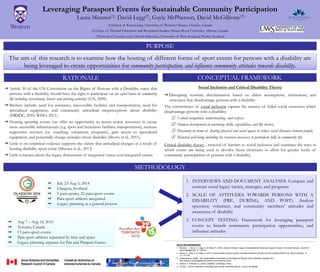Recommended
Iain Lindsey Decentering Sport For Development Isdpa Conf

Iain Lindsey Decentering Sport For Development Isdpa ConfInternational Sport for Development and Peace Association
Recommended
Iain Lindsey Decentering Sport For Development Isdpa Conf

Iain Lindsey Decentering Sport For Development Isdpa ConfInternational Sport for Development and Peace Association
Keynote at Heller School, Brandeis UniversityThe mainstreaming of par in health care final version

The mainstreaming of par in health care final versionNational Research Center for Integrated Natural Disaster Management (CIGIDEN)
More Related Content
Similar to Misener poster
Keynote at Heller School, Brandeis UniversityThe mainstreaming of par in health care final version

The mainstreaming of par in health care final versionNational Research Center for Integrated Natural Disaster Management (CIGIDEN)
Similar to Misener poster (20)
Sociology, Sports Sociology and Human Resource Development

Sociology, Sports Sociology and Human Resource Development
Physical_Activity_Legacy_Glasgow_2014_Commonwealth_Games

Physical_Activity_Legacy_Glasgow_2014_Commonwealth_Games
The mainstreaming of par in health care final version

The mainstreaming of par in health care final version
Extension Program for Sports and Physical Developmentin Higher Education Inst...

Extension Program for Sports and Physical Developmentin Higher Education Inst...
Accessibility of Public Spaces: Case Study of Ikeja, Lagos State, Nigeria

Accessibility of Public Spaces: Case Study of Ikeja, Lagos State, Nigeria
Citizen Science in Open Science context: measuring & understanding impacts of...

Citizen Science in Open Science context: measuring & understanding impacts of...
12: Impact of assistive technologies for mobility and their implications on s...

12: Impact of assistive technologies for mobility and their implications on s...
TOR for evidence based learning documents (2nd version)

TOR for evidence based learning documents (2nd version)
© Pimatisiwin A Journal of Aboriginal and Indigenous Communit.docx

© Pimatisiwin A Journal of Aboriginal and Indigenous Communit.docx
A review of pedestrian group dynamics and methodologies in modelling pedestri...

A review of pedestrian group dynamics and methodologies in modelling pedestri...
A Reflective Lens Applying Critical Systems Thinking And Visual Methods To E...

A Reflective Lens Applying Critical Systems Thinking And Visual Methods To E...
Misener poster
- 1. x Leveraging Parasport Events for Sustainable Community Participation Laura Misener(1), David Legg(2), Gayle McPherson, David McGillivray(3) (1)School of Kinesiology, University of Western Ontario, Ontario, Canada (2) Dept. of Physical Education and Recreation Studies, Mount Royal University, Alberta, Canada (3)School of Creative and Cultural Industries, University of West Scotland, Paisley, Scotland PURPOSE RATIONALE METHODOLOGY The aim of this research is to examine how the hosting of different forms of sport events for persons with a disability are being leveraged to create opportunities for community participation, and influence community attitudes towards disability. CONCEPTUAL FRAMEWORK ➺Article 30 of the UN Convention on the Rights of Persons with a Disability states that persons with a disability should have the right to participate on an equal basis in community life including recreational, leisure and sporting activities (UN, 2009). ➺Barriers include: need for assistance, inaccessible facilities and transportation, need for specialized equipment, and community attitudinal misperceptions about disability (HRSDC, 2010; WHO, 2011). ➺Hosting sporting events can offer an opportunity to access scarce resources to create more accessible infrastructure (e.g. sport and recreation facilities, transportation), increase supportive services (i.e. coaching, volunteers, programs), gain access to specialized equipment, and potentially change attitudes about disability (Sherry et al., 2011). ➺Little to no empirical evidence supports the claims that attitudinal changes as a result of hosting disability sport event (Misener et al., 2013) ➺Little is known about the legacy distinctions of integrated versus non-integrated events Social Inclusion and Critical Disability Theory ➺Disrupting systemic discrimination based on ablest assumptions, institutions, and structures that disadvantage persons with a disability The cornerstones of social inclusion capture the essence of failed social structures which disadvantage persons with a disability: ① Valued recognition, understanding, and respect; ② Human development in nurturing skills, capabilities, and life choices; ③ Proximity in terms of sharing physical and social spaces to reduce social distances between people; ④ Material well-being including the resources necessary to participate fully in community life. Critical disability theory - removal of barriers to social inclusion and examines the ways in which events are being used to devolve those structures to allow for greater levels of community participation of persons with a disability. ➺ July 23-Aug 3, 2014 ➺ Glasgow, Scotland ➺ 5 para-sports, 22 para-sport events ➺ Para-sport athletes integrated ➺ Legacy planning as a general process ➺ Aug 7 – Aug 14, 2015 ➺ Toronto, Canada ➺ 15 para-sport events ➺ Para-sport athletes separated by time and space ➺ Legacy planning separate for Pan and Parapan Games 1. INTERVIEWS AND DOCUMENT ANALYSES: Compare and contrast social legacy tactics, strategies, and programs 2. SCALE OF ATTITUDES TOWARDS PERSONS WITH A DISABILITY (PRE, DURING, AND POST): Analyze spectator, volunteer, and community members’ attitudes and awareness of disability 3. CONCEPT TESTING: Framework for leveraging parasport events to benefit community participation opportunities, and influence attitudes SELECTED REFERENCES: 1. Misener, L., Darcy, S., Legg, D. & Gilbert, K. (2013). Beyond Olympic Legacy: Understanding Paralympic Legacy through a Thematic Analysis. Journal of Sport Management, 27, 329-341. 2. Sherry, E., Karg, A. & O’May, F. (2011). Social capital and sport events: spectator attitudinal change and the Homeless World Cup. Sport in Society, 14 (1), 111-125. 3. United Nations (2009). The United Nations Convention on the Rights of Persons with a Disability. Available from http://www.un.org/disabilities/convention/conventionfull.shtml. 4. Barnes, C. & Mercer, G. (2003). Disability. Cambridge: Polity. 5. LeClair, J. (2012). Disability in the global sport arena: A sporting chance. London: Routledge.

